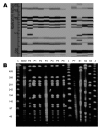Community-associated methicillin-resistant Staphylococcus aureus in hospital nursery and maternity units
- PMID: 15963273
- PMCID: PMC3367583
- DOI: 10.3201/eid1106.040885
Community-associated methicillin-resistant Staphylococcus aureus in hospital nursery and maternity units
Abstract
Community-associated methicillin-resistant Staphylococcus aureus (CA-MRSA) has rarely been reported in the hospital setting. We report an outbreak of 7 cases of skin and soft tissue infections due to a strain of CA-MRSA. All patients were admitted to the labor and delivery, nursery, or maternity units during a 3-week period. Genetic fingerprinting showed that the outbreak strain was closely related to the USA 400 strain that includes the midwestern strain MW2. All isolates contained the staphylococcal chromosome cassette mec type IV. Genes for Panton-Valentine leukocidin and staphylococcal enterotoxin K were detected in all isolates, and most contained other enterotoxin genes. Testing of nearly 2,000 MRSA isolates collected during citywide surveillance studies from 1999 to 2003 showed that approximate, equals 1% were genetically related to MW2. CA-MRSA strain MW2 has been present in this region at least since 1999. This study documents the spread of this strain among healthy newborns at 1 hospital.
Figures


References
-
- Centers for Disease Control and Prevention. Four pediatric deaths from community-acquired methicillin-resistant Staphylococcus aureus infections—Minnesota and North Dakota, 1997–1999. MMWR Morb Mortal Wkly Rep. 1999;48:707–10. - PubMed
Publication types
MeSH terms
LinkOut - more resources
Full Text Sources
Other Literature Sources
